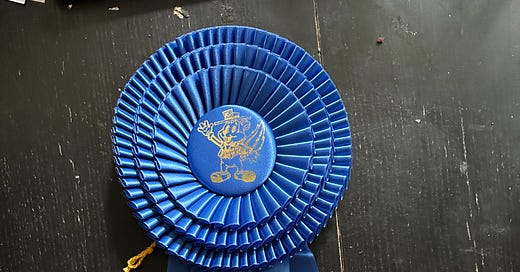For Starters #30: Winning Customers is Competition Enough
“There’s no art in an art contest.” - Augie Carton, Carton Brewing & Steal this Beer podcast
Registration is open for the 2024 Minnesota State Fair homebrew competition. Currently the largest homebrew competition in Minnesota (400 entries across beer, mead, and cider). I’ve been entering for about a decade now, and I occasionally place in a category or two - special shout out to my Belgian Single that took 1st place amongst much higher alcohol Belgian styles last year.
There’s a certain tension with these competitions.
The Beer Judge Certification Program publishes and maintains a list of beer styles [pdf]. From American Light Lager (think Bud Light) to Belgian Witbier (think Hoegaarden) and Finnish Sahti and more than a 100 other styles. Each one with a defined range for every attribute describing a beer; alcohol, hop bitterness, flavor and aroma characteristics, color, even level of carbonation.
In competition, judges compare each entry not to other entries, but to these guidelines - answering the question: How well does this specific entry represent the the specific declared style?
The tension is that subjective criteria like: fun, interesting, and innovative are not part of any style’s guidelines. Winning entries clearly, obviously, and deliciously go right down the middle of the guidelines.
My second job professional job out of college, I was employee #3 at a creative agency attached to a software dev shop. My boss at the time was completely convinced winning an award was exactly what we needed to get the phones ringing with hungry clients.
Yes, we succeeded in winning.
No, the phones did not ring off the hook.
In fact, there was no discernible difference in client interest before or after.
Garrick’s Rule #1.j: “Most things don’t happen”
A couple decades ago, Sean McKay and I were frustrated by design award shows celebrating visual or technical prowess while ignoring business results the creative was purchased to generate in the first place (like the one I just referenced). So, we created one - an award show requiring joint submissions by the creative team and the business client. Our thesis was: If business results are were a key criteria for judging creative work than the winning work would be more informative to all creative professionals.
IIRC, we had fewer than a dozen submissions and all the entrants were hesitant to describe how the work impacted the business. Just highlighting the massive disconnect between creative teams and their clients business goals, and how difficult it is to learn anything from any list of winners.
“I am convinced that about one-half the money I spend for advertising is wasted, but I have never been able to decide which half.” - John Wanamaker
Somewhere recently I read opportunity cost is the one economic concept economists wish more people understood [citation needed].
It’s opportunity cost where pitch competitions really fall down for founders.
The awards I’ve seen fall into three categories:
Credits to utilize a sponsor’s offerings, likely irrelevant to the founder’s current business needs.
Cash no where near amounts to do something substantial with (e.g <$10K).
Cash equivalent to one full-price customer engagement.
It’s this last one where the opportunity stings the most.
If the founder took all the time and effort to succeed in the pitch competition and instead moved their leads down the sales funnel, they’d have much richer and truer information about what the market wants from them and likely an actual sale.
Both are more valuable than approval from randomly selected people. The people running and the people judging the pitch competitions aren’t target customers of any of the businesses competing. Their assessment means little. This is why we don’t ask our friends if they like our business. They’re not our target customers. Just as critically acclaimed movies and highest grossing movies are two different lists, being recognized with an award isn’t commercial success.
That’s if there’s an actual product, in many of these pitch competitions only a slide deck is required. For some it’s simply a Business Model Canvas (a rant for a different day). Both are so disconnected from the realities of the market, disconnected from customers, I’m taken back to the hypothesis Sean and I shared.
Worst of all, like a homebrew judge with the BJCP’s style guide, the winning pitch will best fit the competition’s success criteria - which is not necessarily the one with the greatest commercial success.
Despite how delicious they are, there’s no sense entering experimental beers like my Hazy Norwegian Raw Ale, my 4% ABV Session IPA, or my 2% ABV Historic Brown Ale, into competitions like the MN State Fair. They’re too far outside recognized styles. That’s OK. My five entries this year will be in more recognized styles.
Yes, I started Deja Bru to provide place for interesting styles that don’t have a chance in more other competitions.
Ultimately, the people finding success with a new business venture aren’t bothering with awards. They’re growing their business and living their lives. Winning customers is enough of a competition.




